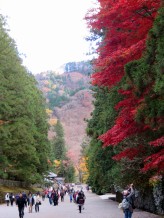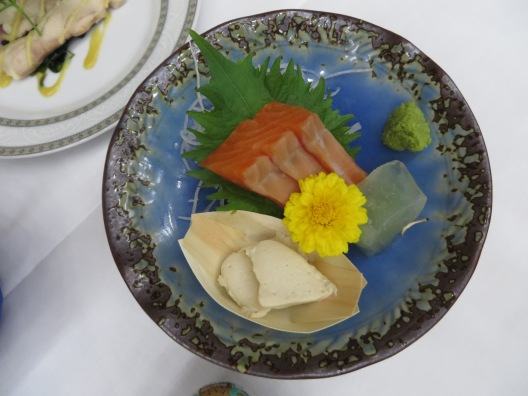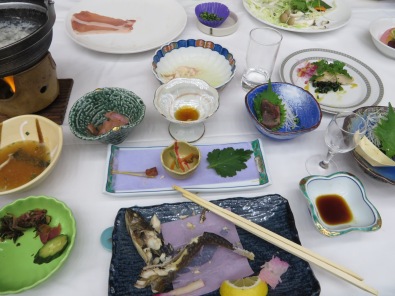I climbed about a bazillion stairs so I could fully appreciate a $40 billion shrine; ate copious amounts of food I can’t identify, let alone name; and disrobed in front of strangers. Yup. Just another weekend travelling in Japan.
Last Saturday, I took several trains and busses to travel roughly 200 kilometers to Nikko with my culture club, a sub-group of one of the spouses’ clubs on base. Each set of American women is matched with a set of Japanese ladies and the groups get together regularly for cross-cultural activities. Nikko was my culture club’s first overnight venture: A girls’ weekend for seven Americans and three of our Japanese friends.
Nikko Toshugu Shrine is a World Heritage site, a 17th century Shinto shrine nestled inside of an eighth century Buddhist mountain town. Beauty abounds.
The shrine honors Shogun leyasu Tokugawa, who is known as a great unifier of Japan. The current shrine was built in 1636, about 20 years after his original shrine was constructed, and would have cost about 40 billion yen in today’s money. I loved the details, including the elaborate carvings everywhere. Who knew that the ‘See No Evil, Speak No Evil, Hear No Evil’ monkeys originated here?
We planned our trip for autumn so we could appreciate the fall foliage. It helped make all the stairs and long uphill paths we had to take both to get to the shrine and visit its many buildings a little more palatable.
After the shrine, we took another bus through the mountains to our hotel, a traditional ryokan. By the time we arrived, it was dark and snowing! (The first I’ve seen since moving here.) Our hotel had an onsen, meaning its facilities included a traditional hot springs bath. More on that later. After relinquishing our shoes at the entrance — they were whisked away into a storage closet — we settled into our rooms. They were sparsely furnished with a low table and mats we could roll out to sleep on. We also found our yukata robes, complete with socks, for wearing around the hotel. We opted not to wear them to dinner, but a few of us got into the spirit of things later and wore them the next morning to breakfast, after taking an early morning dip in the onsen. It’s kind of fun to pad around a hotel essentially in your jammies, especially when that’s what everyone else around you is doing. (No one else seemed self-conscious, so why not?)
We ate two traditional meals during our stay, dinner and breakfast. Thank God I’m not the same picky eater I was in my teens and early twenties. Seat me on the floor in front of an array of tiny bite-sized items, some raw, some cooked, some fish, some meat, some plant, and I’ll now say: Yes, please! For dinner, in addition to the lovely nibbles, we had shabu shabu, which means we individually cooked our own thin slices of pork with noodles and veg in hot pots on the table. Dinner also included a fish with its head attached. I left the head on the plate, but the rest was yummy. Breakfast was similar in content to dinner — lots of fish and rice. I can’t say that I loved all of the flavors and textures of what we ate but I was enthralled by the presentation and by the variety of what we received. I’ve discovered I love pickled things.
After dinner, it was time for our baths. The Japanese love their onsens, or hot spring baths. There are more than 3,000 of them throughout the country and, as I understand it, all pretty much encourage their bathers to follow certain rituals. We wore our yukata robes to the changing room just outside the women’s bath. A few of our members are onsen pros and walked the rest of us through the process. A few nervous giggles and we all shed our robes, folded them neatly, and placed them in baskets in cubbies. Starkers, we walked into the bath area, holding only a very small hand towel for privacy. Before we could plunge into either of the hot pools, we had to wash ourselves. That meant sitting on a low stool in a row of small cubbies, each stocked with a hand showerhead and shampoo, conditioner and body soap supplies. It helped that the room was very foggy from all of the steam so I felt less on display than I might have otherwise. (Plus, there’s safety in numbers, right?
We opted for the outdoor onsen. After I was clean, I walked a few steps over to a sliding door and stepped out into the frigid night. I hurried to the pool, which was similar to a whirlpool in size, with room for maybe eight ladies. I dropped a foot in and, holy moly, was it hot! I managed to step the rest of the way into the pool but all of my skin tingled from the heat. My friends laughed and we all joked about the shock. The water gave off an intense smell of sulfur. The rest of our group joined us and we settled into the water, chatting. It began to snow again, big soft drops that danced in a nearby light and settled gently on the nearby trees. The weirdness of the ritual — the disrobing, the seated public showering — faded away and all that was left was the soothing heat of the water, the patter of good conversation, and the pleasure of sitting out in the cold, mountain air. No wonder the Japanese love their onsens.

























Nikko in all the fall colors looks gorgeous!
LikeLike
It was lovely! I’m so glad we planned our trip for fall!
LikeLike
Bath houses are in Korea also (although I never saw one that was outside!) and the tonier ones could be a delightful experience. How lucky you are to belong to a culture club and have these explained native experiences. It all looks great.
LikeLike
Hi Hilary! The culture club is a huge help. So often Wil and I just feel clueless… That can be fun, in its own way, but actually knowing what’s going on is kind of nice sometimes!
LikeLike
What a great trip! We haven’t been to Nikko yet. I’m gonna send you a private msg on twitter. 😉
LikeLike
You should definitely go! The area around it is beautiful, too. I’ll have to post some pictures of the mountains and lakes.
LikeLiked by 1 person
Beautiful experience. Glad I was there to share it with you. And you forgot to mention our karaoke “concert.” 😜😄
LikeLike
How could I possibly have left out the karaoke??? Shame on me! 😉
LikeLike
> Who knew that the ‘See No Evil, Speak No Evil, Hear No Evil’ monkeys originated here?
When I first came here, I was surprised to learn that 三匹の猿 (“The 3 Wise Monkeys”) are from Japan too.
🙈🙉🙊
LikeLiked by 1 person